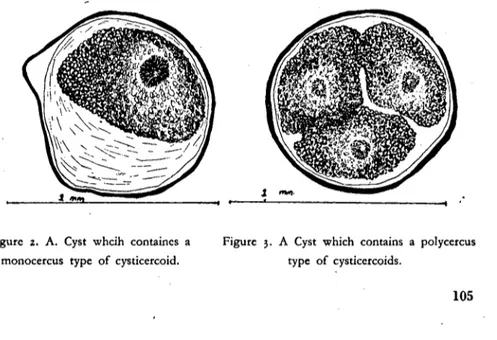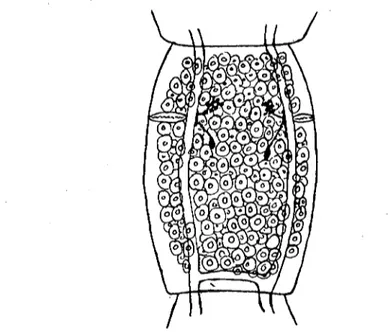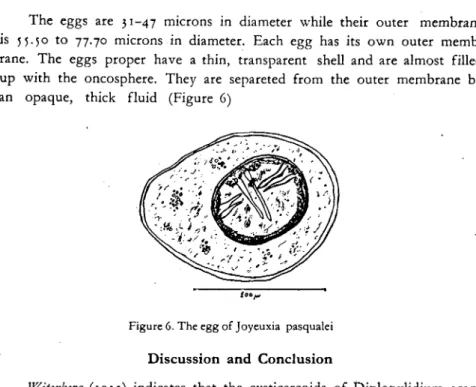Universty of Ankara, Veterinary Faculty, Departmept of Protozoology and Medical Arthropodology
Prof. Dr. Nevzat Tüzdil
THE CYSTICERCOIDS IN LIZARDS (HEMIDACTYLUS
TURCICUS
*)
AND THEIR TRANSMISSION TO A CATMihri Mimioğlu** and Fahri Sayın***
Hemidactylus turcicus is a very common spıcıes in Çukurova, Turkey. They appear during the summer at night and are usually found around bu il-dings. Some of them wruch are hunting flies are even seen near the lamp on the walls or ceillings of porches. We observe that these lizards are prefe-rable prey to cats and think they might be the principle source of the tape worm infections of cats. Therefore we collected several lizards and dissected them to look for cysticercoids of the tapeworms.
In Turkey, the incidense of J oyeuxia pasqualei in cats was found to de very high (56.6
%)
Mimioğlu, 1954.; but there is no available information - about intermediate hosts of this parasite. According to Witenberg (I932) thelife history of certain Dipylidiinae was studied by several authors and the summary of the results is presented by Lopez-Neyra. The author states also the complete life cycle is known only for Dipylidium caninum. The life his-tories of other Dipylidiinae, namely Diplopylidium acanthotetra, J oyeuxia pasqualei, and Joyeuxia echinorhyncoides are only partly clucidated. Their cysticercoid stages are found under the serous layers and in the connective tissue of lizards. Parrot et al (I 920) studied the cysticercoids of Tarentola moritanica and gaye an extensive summary of the works which were done before by several authors. They found cysticercoids on the outside of the wall of intestine of Torentola moritanica. The cysticercoids were fed to baby cats to give rise to adult worms. The adult worms were found ripe on the third week after the infectious feed. The authors identified the m as J oyeu-xia pasqualei and Diplopylidium acanthotetra. Oytun (I 96 I) in-his textbook recorded that Hemidactylus turcicus was one of the intermediate hosts of
,
*
The identification of lizards was made by Prof. Dr. Muhtar Başoğlu, Department of Zoology, Faculty of Scienees, Unuiversty of Ege.**
Prof. Dr. D~pt. of Protozoology and M. Arthropodology.\
.--M. Mimioğlu. F. Sayın
Joyeuxia pasqualei. In palestine, Israel the cysticercoids of Joyeuxia pasqu-alei which are mostly of the polycercus type, were found by Witmberg (1928, 1932) in Hemidactylus turcicus, Acanthodactylus syriacus, Trapeolus rude-ratus, Stellio vulgaris, Zamenis carbonaria, Zamenis dahli and Ailurophis fallax. He indicates that the secondary ho~ts recorded outside Palestine are Lacerta viridis, Lacerta muralis, Varanus griceus and eroicidura suavevo-lens suavevosuavevo-lens. The author was not able to produce infection by feeding the reptiles with gravid segment of the tape worms. He believes therefore the reptiles are secondary intermediate host while the primary ones are probab1y coprophagus insects. As a matter of fact this investigator tried to reproduce the development of the first stage of these worms in ~he house flies (Musca domestica). The larvae of the flies were reared on the rabbit feces to which gravid segments of Joyeuxia pasqualei were added. On consecu-tive days the larvae and hatched insects were carefully dissected, but no ces-tode larvae were found.
Material and Method
i
A total of twenty lizards (Hemidactylus turcicus) were collected in Çu-kurova State Farm. All of these were cought around the farm buildigns and on the walls of porches. They were brought in to the laboratory and dissected to look for cysticercoids. The cysticercoids discovered from the lizards were examined under microscope and. several pittures of these were drown by camera lucida
Two baby cats, about six weeks of age that had begun to eat meat one week ago, were obtained; one of these was fed with seven infected lizards to give rise to adult worms, the other re main ed as a control. The feces of the cats were examined every other day to discover the eggs and gravid segments of the tape worms. The infected cat was treated with a vermifuge at the end of the expriment and the segment s which were passed out in the faces were collected for identifitation.
Results
or
20 lizards, 9 (45%)
are found to carry cystitercoids whith areloca-ted under serous layers and in connective tissue of body cavities and the alimentary traet of the lizards (Figure ı). The cystiscercoids are white, al-most round bodies, usualley o. 6 - I. ; mm. in diameter, and are located
mostly under the serous layers. Theyare included in glo~ular or elongated white cysts of different size up to 2 mm. in diameter. The number of the
.'
Cysticereoidsin lizards
cysts on the serous layers of the body cavities and alimentary tract of the lizards vary from S to so.-The number of contained cysticercoids
(monocer-Figure i. The eysdeereoids in the lizard.
cus or polycercus type in each cyst olso vary from i to ; (Figures 2'and ;).
The cysticercoids are not connected with the cyst wall and swim about in a taransparent fluid. Each cysticercoid contians an e10ngated contractile body and a retractile or invaginable scolex provided with
a
fuIIy developed'.
.'
..•.•.
~__ ~~~ i ••,_~L..- ...•
Figure ı. A. Cyst whcih eontaines a monoeereus type of eystieereoid.
Figure 3. A Cyst whieh contains a polycereus type of eysdeereoids.
lif. ]ılimioğlu - F. Sayın
rostellum and hooks (Figure 4). The body and scolex of the cysticercoids are packed with a dense mass of calcareous corpuscules (rigures 2 and 3)'
The adult tape worms became ripe and the gravid segments began to pass out in the feces of the cat i
ı
\Veeks after the,.infectious feed. The cat was treated 4 \Veeks later and scolex of the parasite \Vas looked for in the feces, but no scolex was found.l' ,"",.
Figure 4. The eystyeercoid whieh cotains a!ongated, eontraeti! body.
The discharged gravid segments 'are rounded or oval, ı. 3 to 5.9 mm. long and ı.5 to 2.ı mm. \Vide. The eggs fil! the whole gravid segments me-dialley and laterally to axcretory vessels. The male opening in the segments is stuated in front of the female opening (Figure 5).
Cysticercoid, in lizards
The eggs are 31-47 microns in diameter while their outer membrane
LS 55.50 to 77.7° microns in diameter. Each egg has its own outer memb-,rane. The eggs proper have a thin, transparent shell and are al most filled up with the oncosphere. Theyare separeted from the outer membrane by an opaque, thick fluid (Figure 6)
Figure 6. The egg of Joyeuxia pasqualei
Discussion and Conclusion
Witenberg (1932) indicates that the cysticercoids of Diplopylidium acan-thotetra, Joyeuxia pasqualei and Joyeuxia echinorhincoides are found un-der the serous layers and in the connective tissue of lizards. He pointed out that in his experiments the cysticercoids of Hemidactylius tuıcicus gave
M. Mimioğlu. F. Sayın
rise to adults of J oyeuxia pasqualei when they were fed to eats. Oytıın (I 96 I) olso reeorded in his textbook that Hemidaetylus turcieus is one of the in-terrnediate host of J oyeuxia pasqualei. The eysticereoids whieh we dise-overed from Hemidaetylus turcieus were also observed under the serous la-yers of the body eavities and alimentary tract. The eystieereoids whieh were diseoverd by Witenberg were mos~ly of polyeereus type. The eysts from Hemidaetylus turcieus in our study were found to eontain eysticereoids which varied from i to 3. Para; et al (1920) stated that the eystieereoids of Tarentole moritanica developed into adults of Joyeuxia pasqualei 3 weeks after being fed to eats. We observed in our experiment the gravid segments of Joyeuxia pasquald began to pass out in the feees 83 days after the eystic-eereoids of Hemodaetylus turcieus were' fed to a eat. According to Witenberg (I 932) (.) The eggs of
J
oyeuxia pasqualei resemble those of ] oyeuxia eehinor-hincoides, but are differently arranged. They fill the whole gravid segment, medialIy and lateralIy to exeratory vessels, while those of the Joyeuxia ee-l1inorhincoides are packed between the exeretory vessels. The author ~tates/
also 1:he eggs of ]oyeuxia pasquald are simillar to those of the Diplopyli-dium aeanthotetra, but the genital openings in the segments are differently sİtuated. The male opening in ]oyeuxia pasqualei is situated in front of the female one, whereas}t is vice versa in Diplopylidium aeanthotetra. In our spe-cimens the gravid segments were filled with eggs medially and laterally to exeretory vessels and the female opening is found behind the male opening. On the basis of these findings we arrived at the eonclusion that the eystieer-eoids which were diseovered from Hemidaetylus ~urcieus in Çukurova are an intermediate stage of ]oyeuxia pasqualei, and Hemidaetylus turcieus sho-uld be an important source of infection of J oyeuxia pasquald to eats.
Summary
Twenty lizards, Hemidaetylus turcicus, were colleeted from Çukurova (Turkey). Nine out of the se (45
%)
were found to earry eysticereoids which were .loeated under serous layers of body eavities and alimentary traets. The eysticereoids were mostly polyeereus type.The eystieereoids were fed to a eat, six week s of age to develop into adults; the gravid segments passed out in the feces 83 day s after infeetious feeding.
it is eoncluded that the eyscieereoids are the intermediatestage of Jo-yeuxia pasquald and Hemidaetylus turcieus should be an important souree of .]oyeuxia pasqualei to eats.
Cysticercoids in lizards
Öze t
Çukurova'dan toplanan 20 kertenkele (Hemidactylus turcicus)'un
dis-seksiyonu yapılarak parazitler aranmıştır. Bunlardan 9 (%45) tanesinin vücut boşluğu ve sindirim sistemi serozası altında policercus ve monocercus tabiatte cysticercoid'lere rasrtlanmıştır. Erişkin paraziti elde etmek gayesiyle, bu cysticercoid'ler, bir hafta önce süt'den kesilmiş, 6 haftalık bir kedi yavru-suna yedirilmiştir. 83 gün sonra kedinin gaitasında parazitin erişkin halka-ları görülmüş ve )oyeuxia pasqualei olarak teşhis edilmiştir. Kardeş olan şahit kedide parazit görülmemiştir. Hemidactylus turcicus'un )oyeuxia pasqualei yönünden, memleketimiz kedileri için mühim bir enfeksiyon kay-nağı olması ihtimali bulunduğu neticesine varılmıştır.
Teşekkür: Gönderdiğimiz kertenkeleleri teşhis etmek lutfunda bulu-nan Ege Üniversitesi Fen Fakültesi Zooloji Kürsüsü Profesörü S~yın Dr. Muhtar Başoğlu'na ve kertenkeleleri toplatarak kürsümüze canlı olarak yol-lamak lutfunda bulunan Çukurova Harası Müdürlüğüne teşekkürü borç biliriz.
References
Blane,C. et Comminopetros, J. (192 i) :Le cystieercoide d' Hemidactylus tur-cims. Bull. Soc. Path. Exot. 20-2i.
Joyeux, Ch. (1916): Sur le cyele evolutij de quelques cestodes. Note preliminaire. Bull. Soc. Path. Exot. IX, 7, 578-583'
Mimioğlu, M. (1954): Parazitolpgische Untersuehunc~enbei Katzen aus Ankara. Zeitschrift für Trop. und Parasi. 5,3. 305-307.
Neveu-Lemaire, M. (1936): Trade d'Helminithologie medicale et Veterinaire. Vigot Frere, Paris.
Oytun, H. S. (1961): Genel Parazitoloji ve Helmintoloji. Veteriner Fakültesi yayınları 55, Ankara.
Parrot, L. et Joyeux Ch. (1920): Les cysticercoidesde Tarentola moritaniea. Bull. Soc. Path. Exot. XIII, 8, 687-696.
Witenberg, G. (I 928): Reptilien als Zwisehenwirte parasdüeher wiirmer VOl1
katze und hund. Tierarztliche Rundschaw 32.
Witenberg, G. (1932): On the cestode subjamily Dipylidiinae Stiles. Zeitschrift Parasitenkunde 4, 3, 542-584.


